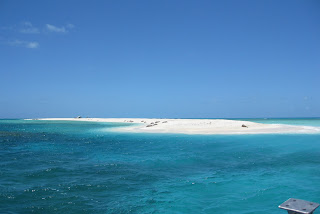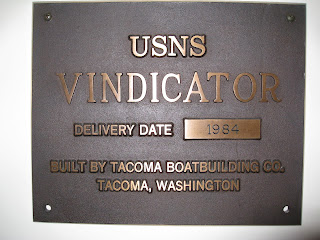July 10th
Fourth day at French Frigate
shoals. Today we took our small boat to Tern Island. We would use this location
as a center point for our receiver retrieval and deployments. The maritime
heritage crew went onto the island to do some filming. Tern island is 56 acres
in area and shaped like a runway. That’s because this island is man-made, once
serving as a takeoff and landing strip for aircraft.
 |
| Side view of the landing strip which makes up the entire island. Lots of birds can be seen |
The French Frigate Shoals served
as seaplane landing and refueling site for Japanese reconnaissance planes
during WWII. Submarines would provide the refueling service, allowing recon
planes to keep a watchful eye on the US Pacific fleet. FFS was used as a
strategic location for “Operation K”, a planned bombing raid on Pearl Harbor
with the intention of disrupting the salvage and recovery effort months after
the Pearl Harbor attack in December 1941. Operation K was then the longest
distance bombing sortie ever planned. Two H8K type-II flying boats were to take
off from the Marshall islands and refuel at French Friagte Shoals (a distance
of 1,900 miles), and then from there fly to Pearl Harbor for the bombing raid. US
Navy intelligence received reports of a planned attack/recon on Pearl Harbor by
Navy code breakers, but these reports were ignored by superior officers. While
the Japanese H8Ks were approaching Pearl Harbor, a US radar station was able to
detect the approaching aircraft, prompting a P-40 warhawk and PBY Catalina to
scramble to intercept the approaching aircraft. Foul weather prevented the
Japanese aircraft from being spotted, luckily it also prevented the Japanese
pilots from carrying out the bombing raid. The two aircraft were separated, one
pilot dropped his bombs into the water, the other could not find Pearl Harbor
and instead, dropped his bombs on the slopes of Tantalas Peak, 1,000 feet from
Roosevelt High School in north Honolulu. The Japanese continued to use French
Frigate shoals as station for reconnaissance on the US fleet, but their cover
was eventually blown by US seaplane tender in May 1942. This played a crucial
role on the development for the upcoming battle of Midway, a pivotal battle
that I will go into great detail into when our ship arrives there. Without
access to French Friagte Shoals, the Imperial Japanese Navy could no longer conduct
the reconnaissance needed to know the position of the US fleet.
 |
| Japanese H8K, two of these used FFS as a refueling station before carrying out an attempted 2nd Pearl Harbor bombing |
In 1942 US Navy SEABEES 5th
battalion constructed the Tern Island run-way out of coral rubble, the material
that makes us the bright-white beaches of the atoll. The island served as
auxiliary Naval Air Station for aircraft flying between Midway and Pearl
Harbor. After the war a tsunami hit in 1946 and the Navy decommissioned the
site. It was later converted to a Coast Guard LORAN station, the runway was
used by Coast Guard and Airforce C-130s. Like many of the islands in the NWHI,
Tern Island was quickly used by a variety of sea birds as a roosting area
(hence the name). US Fish and Wildlife
now operates the field station on Tern Island and Trig Island as well.
Today we got a further first-hand
account of the ecological value of FFS. As many as 18 different species of
birds roost on the islands in French Friagte Shoals. Such species include the Black-footed Albatross, Laysan
Albatross, Bonin Petrel, Bulwer's
Petrel, Wedge-tailed Shearwater, Christmas Shearwater, Tristram's Storm-petrel, Red-tailed Tropic bird, Masked Booby, Red-footed
Booby, Brown Booby, Great
Frigatebird, Spectacled
Tern, Sooty Tern, Blue-gray
Noddy, Brown Noddy, Black Noddy and White Tern.
Many species of terns and boobies surrounded us when our boat approached Tern
island, plus a few frigate birds which have a wingspan longer than my body
length.
Along the shoreline of Trig island
were several large Hawaiian green sea turtles and Hawaiian monk seals. The sea
turtles, called Honu in Hawaiian, use
the shores here as a haul out area where they can mate, nest for their eggs,
and bask in the sun. The Hawaiian green sea turtle was harvested in the
Northwestern Hawaiian Islands for over 150 years. Their population was
decimated, but strict law enforcement under the endangered species act allowed
for the population to rebound. Honu
use the small sandy islands in the NWHI, especially the ones in French Frigate
Shoals, as breeding and nesting grounds. Several (between 500-700) nests have
been found in a single breeding season on Tern Island alone. You can see in my
photos the massive size of the adult turtles on the beaches here, sharing the
islands several sea birds such as boobies and albatross, and monk seals.
The Hawaiian monk seal has not had
the same fortune as the Honu. The
Hawiian monk seal is only one of two truly native land mammals in Hawaii, the
other being the Hawaiian Hoary Bat. The evolutionary backstory of the monk seal
goes back to the North Atlantic, the place origin for the genus Monachus. Migrations through the North
Atlantic to the Mediterranean, and from there across the Panama Canal to the
Hawaiian archipelago, three species resulted in this distribution; the Mediterranean
monk seal, the Caribbean monk seal, and the Hawaiian Monk seal. The Caribbean
monk seal was officially declared extinct in 2008, and the Mediterranean monk
seal has fewer than 500 individuals remaining. The Hawaiian monk seal is listed
as “critically endangered”, with only about 1,100 individuals left, and that
number is declining. The Hawaiian monk seal has been the center for several
species-specific conservation studies.
 |
| A monk seal pup plays alongside it's mother, while she gives attention to her pup and also maintains constant vigilance for predators |
 |
| Trig Island, very small, but a important isle of refuge for many seafaring species |
When we were retrieving our
receiver mooring lines around Trig and Tern Islands, we were very cautious to
the where-abouts of monk seals, especially mother-pup pairs. This was for our
safety and for the monk seals well-being. Like many animals, a mother monk seal
is very protective of her pup, and she can inflict considerable damage or worse
to a diver who unknowingly gets too close. The aggregation of turtles, monk
seals and sea birds brings a lot of shark activity to these islands. Our
receivers detect tiger sharks, Galapagose sharks and Ulua in large numbers very
frequently around these locations.
 |
| Our mooring line with a receiver (black object) just after deployment. T |


































.jpg)






